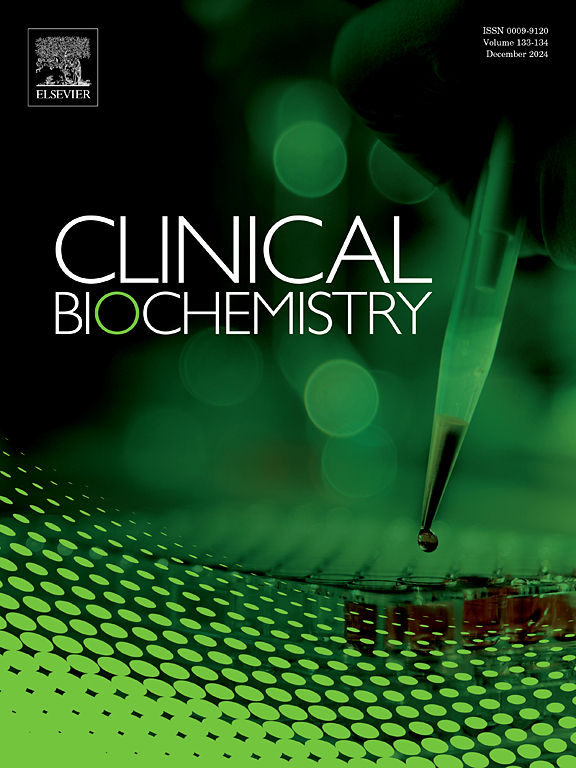Establishing an in-house quality control program for nine autoantibody assays using donor sera
IF 2.5
3区 医学
Q2 MEDICAL LABORATORY TECHNOLOGY
引用次数: 0
Abstract
Background
Clinical laboratories performing semi-quantitative autoantibody testing face challenges in developing quality systems to assure performance. Careful consideration is required to evaluate assay imprecision, including quality control (QC) matrix, autoantibody titer targets, and performance goals. The objective of this study was to evaluate the performance of a novel patient-based QC solution relative to vendor-provided QC for nine autoantibodies over a four-year period at a tertiary pediatric care centre.
Methods
Internal QC data were extracted over a 4-year period for nine autoantibodies measured via chemiluminescent immunoassays (anti-double stranded DNA (dsDNA), anti-ribonuclear protein, anti-Ro52, anti-Ro60, anti-La, anti-Smith, anti-proteinase 3, anti-myeloperoxidase, and anti-tissue transglutaminase IgA). QC evaluated during study period included vendor-based QC and third-party patient-based QC using defibrinated plasma specimens from autoantibody positive single donors. Lot-specific QC coefficients of variation (CV), titer means, and standard deviations were calculated and compared across QC matrices.
Results
Approximately 500 QC values per autoantibody were evaluated. Mean CV across lots ranged from 8.2 to 14.4% for negative vendor-based QC, 8.2–14.5% for positive vendor-based QC, and 9.8–17.8% for positive patient-based QC across evaluated autoantibodies. Imprecision estimates were similar between positive vendor and patient-based QC for all autoantibodies with the exception of anti-dsDNA (vendor: 4.8–13.2%, patient-based: 14.3–21.6%) and anti-Ro52 (vendor: 6.9–12.4%; patient-based: 9.7–18.9%).
Conclusions
This study characterizes imprecision across different QC matrices for nine autoantibodies measured semi-quantitatively using chemiluminescent immunoassays. Results may serve as a benchmark tool to assess imprecision goals for commonly measured autoantibodies in clinical laboratories and as a framework for utilizing third-party patient-based QC solutions.
用供体血清建立9种自身抗体测定的内部质量控制程序
进行半定量自身抗体检测的临床实验室在开发质量体系以确保性能方面面临挑战。需要仔细考虑评估测定的不精确性,包括质量控制(QC)基质、自身抗体滴度目标和性能目标。本研究的目的是评估一种新型的基于患者的质量控制解决方案的性能,相对于供应商提供的质量控制解决方案,在一个三级儿科护理中心进行了四年的9种自身抗体检测。方法采用化学发光免疫分析法提取9种自身抗体(抗双链DNA (dsDNA)、抗核糖核蛋白、抗ro52、抗ro60、抗la、抗smith、抗蛋白酶3、抗髓过氧化物酶和抗组织转谷氨酰胺酶IgA) 4年的内部QC数据。在研究期间评估的质量控制包括基于供应商的质量控制和基于第三方患者的质量控制,这些质量控制使用来自自身抗体阳性的单个献血者的去纤血浆标本。定量QC变异系数(CV)、滴度平均值和标准偏差被计算并在QC矩阵中进行比较。结果每个自身抗体约500个QC值被评估。在评估的自身抗体中,基于供应商的QC阴性的批次平均CV为8.2 - 14.4%,基于供应商的QC阳性的批次平均CV为8.2 - 14.5%,基于患者的QC阳性的批次平均CV为9.8-17.8%。除了抗dsdna(供应商:4.8-13.2%,患者:14.3-21.6%)和抗ro52(供应商:6.9-12.4%;基于:9.7 - -18.9%)。结论利用化学发光免疫分析法对9种自身抗体进行半定量检测,发现不同QC基质间的不精确性。结果可以作为评估临床实验室中常用自身抗体不精确目标的基准工具,并作为利用第三方基于患者的质量控制解决方案的框架。
本文章由计算机程序翻译,如有差异,请以英文原文为准。
求助全文
约1分钟内获得全文
求助全文
来源期刊

Clinical biochemistry
医学-医学实验技术
CiteScore
5.10
自引率
0.00%
发文量
151
审稿时长
25 days
期刊介绍:
Clinical Biochemistry publishes articles relating to clinical chemistry, molecular biology and genetics, therapeutic drug monitoring and toxicology, laboratory immunology and laboratory medicine in general, with the focus on analytical and clinical investigation of laboratory tests in humans used for diagnosis, prognosis, treatment and therapy, and monitoring of disease.
 求助内容:
求助内容: 应助结果提醒方式:
应助结果提醒方式:


